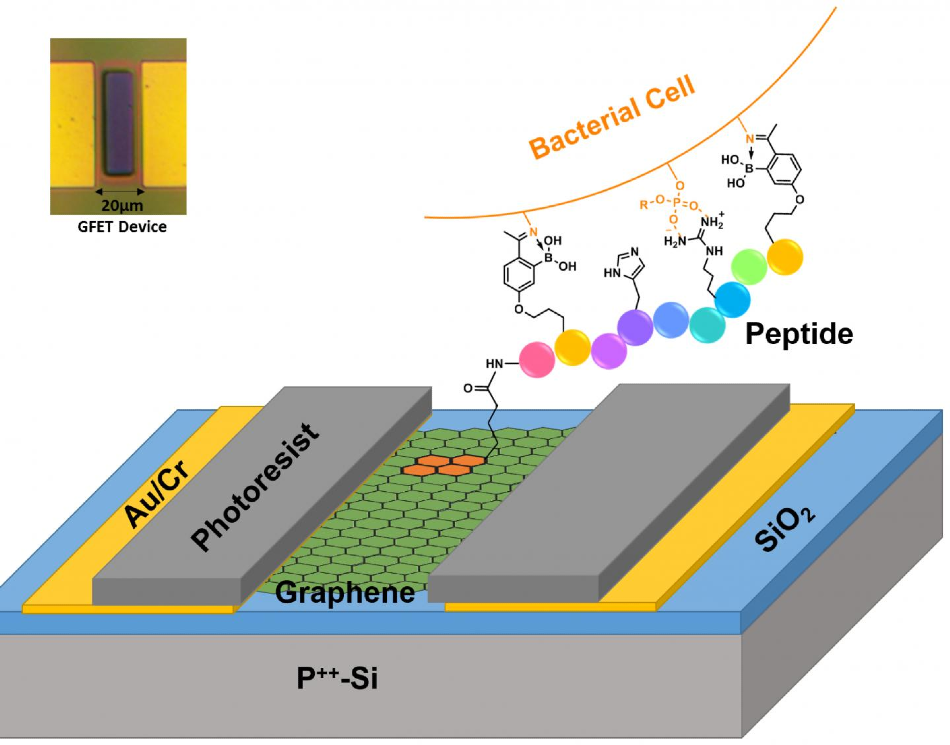Mar 20 2020
Researchers have used a single-atom-thick graphene sheet to detect the electronic signals intrinsic to biological structures, thereby developing a platform for selective identification of lethal strains of bacteria.
 The difficulty and expense of determining the precise pathogen causing an infection is a key part of the complexity of antibiotic treatments. A team led by Boston College researchers has developed a prototype sensor that uses an atom-deep sheet of graphene and peptides to rapidly reveal which bacterial species is in a sample and whether it is antibiotic-resistant. The graphene field-effect transistor (G-FET) achieved single-cell resolution and a 5-minute detection time, which could lead to more accurate targeting of infections with appropriate antibiotics. Image Credit: Kenneth Burch, Boston College.
The difficulty and expense of determining the precise pathogen causing an infection is a key part of the complexity of antibiotic treatments. A team led by Boston College researchers has developed a prototype sensor that uses an atom-deep sheet of graphene and peptides to rapidly reveal which bacterial species is in a sample and whether it is antibiotic-resistant. The graphene field-effect transistor (G-FET) achieved single-cell resolution and a 5-minute detection time, which could lead to more accurate targeting of infections with appropriate antibiotics. Image Credit: Kenneth Burch, Boston College.
The study was led by Boston College and the advance could result in highly accurate targeting of infections with suitable antibiotics, as described by the researchers in the Biosensors and Bioelectronics journal.
According to Kenneth Burch, Boston College Professor of Physics and one of the lead co-authors of the study, the prototype depicts the first-ever fast, selective, and economical electrical tracking of Staphylococcus aureus (a pathogenic bacterial species) and antibiotic-resistant Acinetobacter baumannii on a single platform.
The quick increase in antibiotic-resistant pathogenic bacteria has turned out to be a worldwide threat, mainly because of the over-prescription of antibiotics. This is triggered mainly by the dearth in scalable, quick, accurate, and inexpensive diagnostics, says Tim van Opijnen, Boston College Associate Professor of Biology who is also a co-author of the study.
Of specific importance is the identification of the bacterial species and whether it is antibiotic-resistant, as well as to perform this in a platform that can be simply operated at most of the points of care. At present, such diagnostics are comparatively slow, requiring a few hours to a few days to complete, and necessitate wide-ranging expertise and high-cost equipment.
The researchers at Boston College collaborated with colleagues from Boston University to create a sensor, called a graphene field-effect transistor (G-FET), with the ability to resolve major disadvantages of earlier detection efforts. This is because it is a highly scalable platform that makes use of peptides, chains of several linked amino acids, which are user-friendly and economical chemical agents, said Jianmin Gao, BC Professor of Chemistry who is another co-author of the study.
The researchers endeavored to demonstrate that it is possible to develop a device with the ability to “rapidly detect the presence of specific bacterial strains and species, exploiting the large amount of electric charge on their surface and ability to capture them with synthetic peptides of our own design,” stated Burch.
The initiative was founded on the previous study of van Opijnen and Gao, which found that peptides were highly selective. That study necessitated the use of high-cost fluorescence microscopes for the investigation. Apart from Burch, Gao, and van Opijnen, Xi Ling, a Boston University Assistant Professor of Chemistry, is the lead co-author of the study.
The researchers tweaked existing peptides to enable them to bind to graphene, a single atomic layer of carbon. The peptides were developed to attach to particular bacteria and reject all others. In principle, the G-FET can detect the electric charge on the graphene, while exposing it to different biological agents.
By tapping the selectivity of the peptides, the team could direct their attachment to the preferred bacterial strain, as described in the paper titled “Dielectrophoresis assisted rapid, selective and single cell detection of antibiotic resistant bacteria with G-FETs.” The researchers electrically monitored the resistance and, finally, charge on the device, thus resolving the presence of bacteria bound to graphene, even in the case of just a single cell.
To achieve high sensitivity and greater speed, the team placed an electrical field on the liquid to direct the bacteria toward the device, thus again leveraging the charge on the bacteria. This process is termed dielectrocphoresis and had never been applied earlier to graphene-based sensors. According to the researchers, the process could pave the way to drastically enhancing efforts in that field to use graphene for biosensing.
We were surprised how well the bacteria were electrically guided to the devices. We thought it would somewhat reduce the required time and needed concentration. Instead, it worked so well that the electric field was able to bring needed concentration of bacteria down by a factor of 1000, and reduce the time to detection to five minutes.
Kenneth Burch, Professor of Physics, Boston College